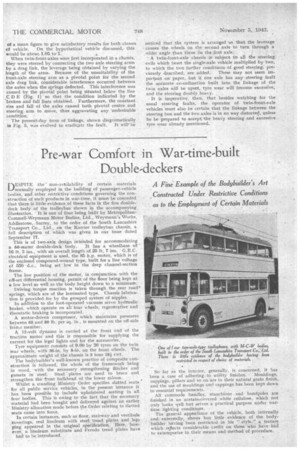Pre-war Comfort in War-time-built Double-deckers
Page 28

If you've noticed an error in this article please click here to report it so we can fix it.
FIESFITE the rion-artilability• of certain materials 11-inormally employed in the building of passenger-vehicle bodies, and other restrictive conditions governing the construction of such products in war-time, it must he conceded that there is little evidence of these facts in the fine doubledeck body of the trolleybus shown in the accompanying illustration. It is one of four being hUilt by MetropolitanCammell-Weymann Motor Bodies, Ltd., Weymann's Works, Addlestone, Surrey, to the order of the South Lancashire Transport Co., Ltd., on the Harrier trolleybus chassis, a full description of which was given in our issue dated September 17.
This is of two-axle design intended for accommodating a 66-seater double-deck body. It has a wheelbase ot 16 ft. 3 ins., with an overall length of 25 ft. 7 ins. G.E.C. electrical equipment is used, the 85 h.p. motor, which is of the enclosed compound-wound type, built for a line voltage of 550 d.c., being set low in the deep channel-section frame.
The low position of the motor, in conjunction with the off-set differential housing, permit of the floor being kept at a low level as well as the body height down to a minimum.
Driving. torque reaction is taken through the .rear road• springs, which are of the laminated type. Chassis lubrication is provided for by the grouped system of nipples.
In addition to the foot-operated vacuum servo hydraulic brakes, which operate on all four wheels, regenerative and rheostatic braking is incorporated.
A motor-driven compressor, which maintains pressures between 65 and 80 lb. per sq. in., is mounted-on the off-side frame member.
A 12-volt 'dynamo is carried at the front end of the tractiOn motor and this is responsible for supplyin.g the current for the legal lights and for the accessories.
Tyre equipment consists of 9.00 by 20 tyres on the twin rear wheels, with 36-in. by 8-in, on the front wheels. The approximate weight of the chassis is 3 tons 181 cwt. The bodybuilder's well-known practice of composite construction is followed, the whole of the framework being in wood, with the necessary strengthening flitches and gussets in steel. Steel plates are used to brace and strengthen the front bulkhead of the lower saloon.
Whilst a standing Ministry Order specifies slatted scats for all public service vehicles, in the present instance it has been possible to include upholstered seating in all four bodies. This is owing to the fact that the necessary material had been bought and delivered against an earlier Ministry allocation made before the Order relating to slatted seats came into force.
In certain instances, such as floor, stairway and vestibule coverings, real linoleum with steel tread plates and lapping appeared in the original specification. Here, however, a linoleum substitute and -Ferodo tread plates have had to be introduced.. So far as the interior, generally, is concerned, it has been a case of adhering to utility finishes. Mouldings, cappings, pillars and so on are in their natural grain finish, . and the use of mouldings and cappings has been kept down to essential requirements.
All commode handles, stanchions and bandpoles are .finished in an acetate-cnvered white cellulose, which not only looks well but serves a practical purpose under wartime lighting conditions.
The general appearance of the vehicle, both infernally and externally, shows but little evidence of the bodybuilder. having been restricted in his '! style,". a feature which .reflects considerable credit on those who have'hael to extemporize in their means and .method of procedure.




















































